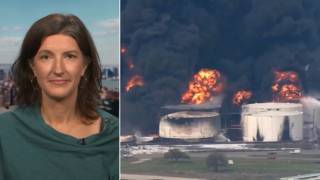
Topics
Guests
- Jay Hicksdirector of new media for KWTX-TV in Waco, Texas.
- Tony Dudikfarmer who lives near West, Texas. He volunteered at a triage center three miles from the blast last night.
An unknown number of people have been killed, and well over 100 injured, in a massive explosion at a fertilizer plant in West, Texas. The incident began with a smaller fire that ignited chemical tanks, causing an explosion that shot flames high into the air and leveled surrounding buildings for blocks in each direction. A police official estimated five to 15 people have died, but the casualty count is expected to rise as day breaks. One initial estimate put the death toll at between 60 to 70 people. Local officials say around a half dozen volunteer firefighters who first arrived on the scene are now missing. Toxic fumes rising from the rubble of the plant have raised health concerns, and about half the town has been evacuated, including a nursing home. We go to Texas to speak with reporter Jay Hicks of the Waco television station KWTX, and Tony Dudik, a local resident who volunteered aid at a triage center three miles from the blast. “It was devastation beyond description,” Dudik says. [includes rush transcript]
Transcript
JUAN GONZÁLEZ: We begin today’s show with breaking news in Texas, where an unknown number of people are dead and well over 100 injured after a massive explosion at a fertilizer plant near the town of Waco. The incident began with a smaller fire that ignited chemical tanks, causing an explosion that shot flames high into the air. A police official estimated five to 15 people have died, but the casualty count is expected to rise as day breaks. Some of the victims are first responders who reacted to the initial blaze.
Dr. George Smith, medical director of West EMS, said 60 or 70 people may have perished.
DR. GEORGE SMITH: There was just a major, major explosion. The windows came in on me. The roof came in on me. The ceiling came in. I worked my way out to go get some more help. Of course, we lost all communication, because the power went out.
AMY GOODMAN: Toxic fumes rising from the rubble of the plant raised major health concerns. Half the town was evacuated. Buildings were gutted. Dozens of homes were damaged. And several residents of a nearby nursing home were reportedly missing. D.L. Wilson, a state trooper with the Texas Department of Public Safety, compared the destruction to war.
D.L. WILSON: I can tell you I was there. I walked through the blast area. I searched some houses earlier tonight. Massive, just like Iraq, just like the Murrah Building in Oklahoma City. Same kind of anhydrous exploded, so you can imagine what kind of damage we’re looking at there. I know there was at least 75 or 50—50 to 75 houses damaged. There’s an apartment complex that has about 50 units in it that was completely—just skeleton standing up. There’s a nursing home in the area that 133 people in the nursing home. We got them evacuated. I don’t know what their injuries are there right now. But all injuries have been removed from the scene and taken to local hospitals in the Waco area.
AMY GOODMAN: For more on this developing story, we go to the nearby town of Waco, Texas, where we’re joined from the studios of news station KWTX by [Jay] Hicks, the station’s new media director. We’re also joined by Mike Elk, a labor reporter for In These Times magazine, who’s reporting on the explosion in West, Texas, since it happened last night. Let’s go to Jay Hicks first in Waco.
Describe what you understand has happened until this point, Jay.
JAY HICKS: What I’ve understood is, around 7:50, calls went out. Emergency calls on the scanners completely lit up. And after that point it’s been complete chaos. We know that there was an explosion. We know that it spread to the local nursing home, as well as an intermediate school that’s very close by. And from there, they evacuated many of the senior citizens in the nursing home. And fortunately, there wasn’t anyone, according to the West superintendent, that were in the school. There weren’t any students, and there weren’t any custodial staff.
And after that, it’s really been a search and rescue. It’s been about finding people, figuring out which hospital to take them to, and really just the organizations trying to figure out some of the folks that are missing. We know that there have been confirmed deaths—six firefighters, one police officer—and the city manager is also missing in action right now.
JUAN GONZÁLEZ: Jay Hicks—Jay Hicks, is there any indication of what was occurring at the plant before first the fire broke out and then the—and then the explosion? Was the plant involved in any kind of special maintenance or other work that might have triggered the fire?
JAY HICKS: It’s not known. We really haven’t been able to come in contact with anyone. I spoke to the niece of the gentleman who owns the facility. She was unable to get in touch with anyone in her family. So we really don’t have any insights into what was going on in the facility. The only thing we do know is obviously we’ve checked the records, and we know that in 2006 the plant was cited by the state’s regulatory agency for not having a safety plan. So, beyond that, we really don’t have much look into, sight into what was going on inside the factory prior to the explosion.
AMY GOODMAN: And, Jay, The Dallas Morning News is reporting documents show that the fertilizer plant that exploded in West, Texas, reported to the EPA and local public safety officials that it presented no risk of fire or explosion.
JAY HICKS: Well, right. We know that that was filed. And obviously we know that right now the city of West, in terms of facts that we know, have been absolutely devastated, as the reports that you’ve received and heard, and, again, the words and the descriptions are a war zone. You know, many of the homes, the brick looks like it’s actually been almost blasted off of the homes nearby. And so, we know that those claims were filed, but we also know that there’s been a very tragic explosion that has probably changed West in a way that it will be forever changed.
JUAN GONZÁLEZ: And as daylight now has come to West and to the Waco area, what’s going on right there now? Are there still—the bodies are still there of those who have died? And is the area still completely cordoned off?
JAY HICKS: Well, the area is actually—they’ve spread out the area in terms of where they will allow media. The conditions have actually turned really—you know, made it more difficult for search and rescue. You probably can’t hear, but at the station where I’m located there’s actually the pounding of rain on the roof. You know, the visibility is really low right now. You can probably only see maybe several hundred feet. The temperature dropped in the last couple of hours. And there’s also a wind that’s coming through. So, you know, not exactly ideal conditions that they’re dealing with. I think it’s going to be a struggle this morning to get out there with the rain, the wind and the cold weather. I know that the officials here will do the best job, but they definitely have their work cut out because of conditions. As I said, the rain is pouring right now.
AMY GOODMAN: Jay Hicks, can you describe the area where you live, Waco, and nearby in West? I mean, this is an enormous facility—clearly, the toxic anhydrous ammonia, tens of thousands of pounds of it. Has it been a concern? And can you talk about who you believe is lost at this point, like the firefighters, the city manager?
JAY HICKS: Well, right. We know those; those are confirmed lost, except for the city manager. In terms of the facility, you know, West is a smaller town, as you’ve—as everyone has been learning about West, 2,600 or so people, really a town that—known around the world for great football. You know, kind of Friday night under the Texas lights, many people in that town come out for the West High School football team, which is actually a smaller school but has a very strong tradition of having some competitive teams. In terms of who lives there, a lot of the people—it’s 15 minutes outside of Waco, which is—Waco is around 200,000 people. It’s a smaller town. So some people work in and around Waco. So, it’s kind of a stretched-out, maybe, bedroom community, a little bit of a rural community, a tight-knit community. So I think this will definitely be a sledgehammer to the city.
JUAN GONZÁLEZ: What’s been the response of Governor Perry at all? Has he made statements or come to the scene?
JAY HICKS: He has made statements. He made some—the last statement that I saw on Twitter was around 9:00 p.m. yesterday. He said that he was sending all state resources to support the efforts and said he was praying for the people of West. And that’s what we’ve heard thus far.
AMY GOODMAN: We’ve just been joined on the telephone by Tony Dudik, who is a local farmer, at the scene last night helping victims. Tony, can you describe what you saw last night?
TONY DUDIK: It was—I was not at the blast scene, let me clarify that. From where I was at was a good—I was a good three miles, at the West community center. The fertilizer plant, West Fertilizer, is kind of on the north side of town. I was on the extreme southern side of town, so there was a pretty good size of territory between where I was. But I was at one of the triage staging points. I left my home about 10 minutes from West, and I told my wife, I said, “I’ve got to go.” I used to be a volunteer fireman years ago, and they were asking for help. I got there to the triage center and immediately started assisting with triage with many of the nursing home residents, and there’s also assisted living housing right near there. It was—I described it last night as something that you would have seen at the Murrah Building in 1995. I remember that explosion very well.
AMY GOODMAN: In Oklahoma City.
TONY DUDIK: And it was—it was just—it was devastation beyond—beyond description. There are not words in the English language to describe. And now that it’s getting daylight, there’s not words to describe the devastation that we’re going to see from the air.
AMY GOODMAN: And that was a fertilizer bomb in Oklahoma City.
TONY DUDIK: It was. It was.
AMY GOODMAN: This month, it was exactly this week in 1995, April 19.
TONY DUDIK: Let me—let me say this before you—don’t—I don’t want folks to get too far ahead in their thinking. We knew that was a bomb in Oklahoma City. There are all the right components for a bomb can be found right—or could have been found, right there at West Fertilizer. Anhydrous ammonia, those chemicals, can be terribly unstable if the conditions are right. I’ve seen—not anything of this magnitude. I’ve seen grain elevators explode, with a lot of destruction. I mean, it’s like a bomb going off. But let’s don’t get—let’s don’t say this is an act of terror or anything. I think it’s just a—just a plain, unfortunate—
AMY GOODMAN: Oh, no, we were in no way—in no way were we suggesting that.
TONY DUDIK: Yeah.
AMY GOODMAN: Just the point was that that shows the power of when fertilizer blows up.
TONY DUDIK: Oh, it’s incredible.
AMY GOODMAN: Yeah.
TONY DUDIK: It is incredibly devastating.
JUAN GONZÁLEZ: And, Tony, Tony Dudik, I’d like to ask you, do you—from where you were, could you tell the—how long was the period between the actual—the fire breaking out and the firefighters responding and the actual explosion?
TONY DUDIK: That, I do not know. I did—I spoke with a colleague that I teach with shortly before I went up there, and he was at a meeting in West not too far from where West Fertilizer is. I’d say, by air, it was less than three-quarters of a mile north of where West Fertilizer is. He said there were people coming out to the meeting, and he said they saw smoke before the explosion. Somebody just thought, “Oh, well, there’s somebody house, you know, or somebody’s burning some brush or trash,” and nobody really thought about it. They heard the sirens, and they knew—they knew that the West Fire Department was responding. And then, just a very, very short period of time, probably less than 15 minutes, is what he said, they heard the explosion. Now, he was—he was nearly a mile away in a steel building, a large, big steel building. He said it knocked the—the concussive force was so strong, it knocked the light bulbs out of fixtures, insulation out of the hanging ceiling. He said he literally felt the ground shake. My father and my cousin were eight miles away at our farm west of there, and my dad described it as feeling like an earthquake. And that’s eight miles—eight miles away from there.












Media Options